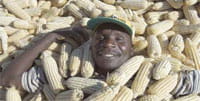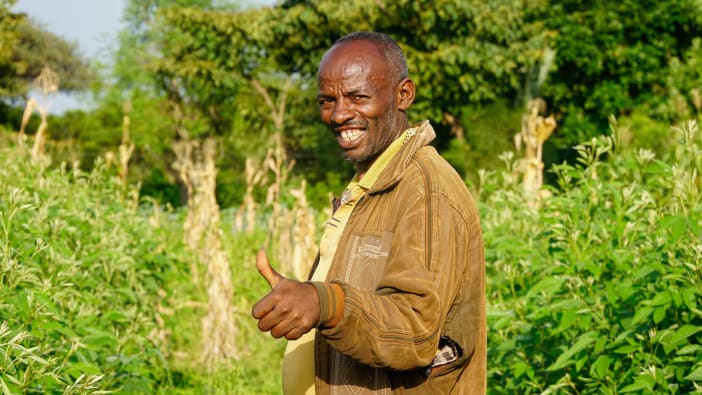In many countries in southern Africa, food insecurity is increasing. Drought is a key factor, but farming practices are also a major cause. Food insecurity is a particular issue in rural areas, where agriculture is the main economic activity. In 2002 the Evangelical Fellowship of Zambia (EFZ) identified three districts where help was needed to improve food security.
Developing the food security programme
EFZ first carried out a needs assessment in one of the districts. The results showed that the lack of food in the area was caused mainly by the farming practices used. The needs assessment also showed that some farmers in the area had reaped a successful harvest in spite of the droughts. This was due to their knowledge and practice of conservation farming methods over a long period of time. These farming methods aim to conserve soil and water while at the same time providing a sustainable livelihood for the farmer.
After the needs assessment, EFZ worked alongside village committees to design a food security programme. This programme targeted more than 2,000 households. One of the key parts of the programme was the promotion of conservation farming in place of the conventional farming methods that were being widely used in the area. Some of the differences between conventional and conservation farming methods are explained in the box below.
Due to the proven benefits of Conservation Farming the Government of Zambia had already been promoting it across the country. EFZ decided to work alongside the Ministry of Agriculture and the Conservation Farming Unit (CFU) to distribute information about conservation farming to the households targeted by the programme. Each farmer was also provided with seed and fertiliser.
Community meetings were held in which the programme was explained to the target households. Later on, workshops about conservation farming were carried out to train people to become trainers at community level. These trainers were expected to train individual farmer households through village-based training workshops. Farmer co-operatives were set up to enable the programme to reach farmers. Poor farmers were encouraged to join a Farmer co-operative themselves.
Results
After the harvest the households realised that the fields that had been farmed using conservation methods had yielded more than those that had used conventional methods. Other surveys confirmed that conservation farming produced on average 1.5 tonnes more maize per hectare than conventional farming. In addition, the techniques used in conservation farming meant that less fertiliser was needed.
Conservation farming improved food security for farmers because it minimised crop loss during drought.
Learning points
The knowledge and experience of conservation farming is increasing in Zambia, and gradually more households are adopting the techniques. EFZ’s review had the following learning points:
- The practice of even just one or two conservation farming techniques is beneficial. Farmers give themselves a chance to test the benefits and gain confidence before using other conservation farming methods.
- Some farmers decided to introduce conservation farming methods to only one of their fields. This meant that they could compare the results with those of conventional farming techniques. They usually found that conservation farming techniques brought higher yields.
- Success related to conservation farming will vary between regions, between crops and over time. This is mainly due to changes in weather patterns.
- Many of the benefits of conservation farming will occur gradually. It is worth investing in conservation methods, but it will probably take time to see the full benefits.
Joan Mute is a Programs Manager in the Ethics, Society and Development Department of the Evangelical Fellowship of Zambia.
Plot 8665, Kamloops Avenue, Lusaka 10101, Zambia.
Email: [email protected]
Some examples of the differences between conventional and conservation farming
Conventional farming
Some aspects of conventional farming negatively affect crop yields:
- Burning of residues (crop waste) before ploughing Residues are useful for:
- protecting the soil from being washed away, improving water infiltration and reducing soil temperatures
- maintaining soil structure and fertility when termites and worms incorporate them into the soil.
- Ploughing using oxen Ploughing the whole field wastes energy, reduces yields and destroys the soil:
-
Farmers usually plough after the rains. This means that there is a delay in preparing the land. For each day of delay after the first planting rains, some of the potential yield is lost.
-
The ploughed soil is exposed to wind and rain which remove the surface soil.
-
- Ridging up with a hoe This is where ridges are made into the soil to leave furrows that act like a drain. The problem with this is that rain water starts to erode the ridges and gullies soon develop.
- Hoe minimum tillage This is where a hoe is used during the first good rains to make planting holes or to scratch planting lines. It is easier to do than ploughing and uses less labour. However, as the soil between the holes or planting lines remains hard, the rain runs off it and takes the fertilisers with it.
Conservation farming
This is a combination of methods which aim to conserve water, soil quality, moisture, fertility and seed production, as well as the farmer’s energy, time and money. Some of the key aspects and benefits include:
- Planting in basins Farmers create basins in the soil in which seeds can be planted. When the rains come the water is trapped in the basins, allowing roots to develop and stopping the top soil and fertiliser being washed away.
- Leaving crop residue for the next harvest Farmers are encouraged to leave the residues rather than burning them. This reduces soil and water loss, improves infiltration, reduces surface temperatures and in time improves soil fertility. Because seeds are planted in the same basin each year, the fertiliser left from the previous crop can be absorbed by the new crop.
- Nitrogen-fixing crop rotations Farmers are encouraged to grow legumes and other nitrogen-fixing crops in rotation to increase the natural soil nutrients. This will reduce the need for artificial fertiliser and enable them to diversify from maize into less hardy crops.
- Early planting during the first rains This means that farmers need to prepare land as soon as they have harvested the previous crop. Planting during the first rains enables the seeds to benefit from the nitrogen that the rains flush through the soil.









